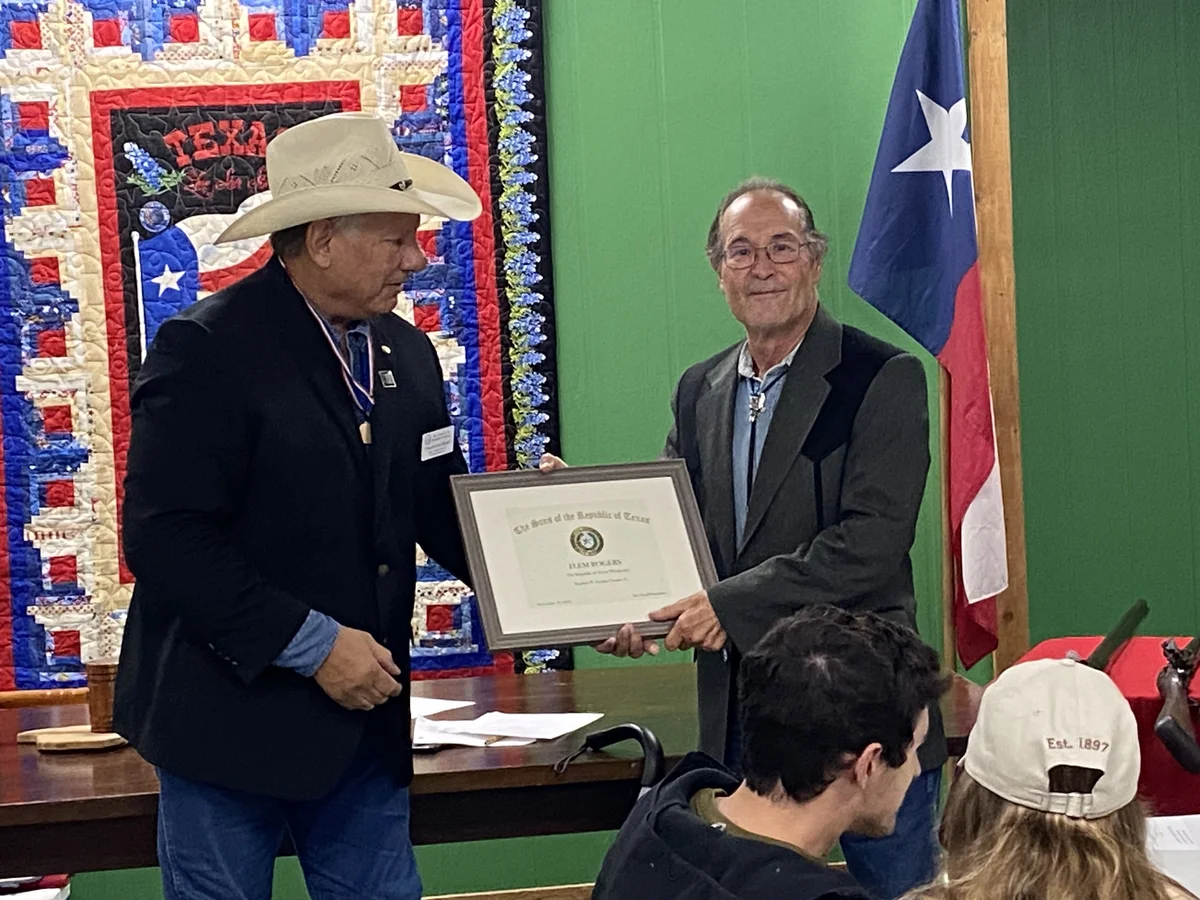![]()
By Tracy Gupton
Long range missiles, drones and devastating bombs are the norm in modern warfare across the globe in the present day. But when the great state of Texas was in its infancy 200 years ago more rudimentary weapons were commonly utilized.
Columbia Historical Museum Board Member Flem Rogers recently shared his knowledge of weaponry from that era in a presentation he made to the Sons of the Republic of Texas at their meeting at the Stephen F. Austin Statue Museum near Angleton in late 2023. Rogers displayed guns and swords from his personal collection when speaking to the local SRT gathering.
“All of my stuff is treated up to museum standards,” Rogers said. Among the early 19th Century rifles he displayed was a flintlock musket similar to those used by early Texas settlers in the 1820s.
“You’ve all heard the saying ‘Keep your powder dry,’” Rogers remarked, indicating the importance that dry gunpowder was critical for muskets of the 1820s to function properly.

Photo by Tracy Gupton
Flem Rogers of East Columbia, right, was presented a plaque thanking him for speaking to the local Sons of the Republic of Texas group recently by the group’s president, Ray Beall, at the Stephen F. Austin Statue Museum near Angleton. Rogers is a member of the Columbia Historical Museum’s Board of Directors.
He also showed the SRT members and guests in attendance late last year his smoothbore Virginia musket, as well as his Kentucky rifle that was like those used by our ancestors in the early days of the Republic of Texas. Rogers said the muskets from the 1830s had a maximum effective accuracy range of only about 35 yards.
One interesting point to consider is that, in 1836 when Columbia was the first capital of the new Republic of Texas, combatants were transitioning from flintlock to percussion caps, so both types of ignition systems almost certainly saw action during the Texas settlers’ struggle for independence from Mexico.
Frontiersmen from early Texas days would have likely been armed with long rifles. Rogers emphasized in his talk that these rifles would have been fitted with iron cartridge holders which made an effective club once the one round was discharged.
He said it was common practice for settlers in early Texas days to have shooting contests after church on Sundays to show off one’s shooting skills. Rogers said that women in early Texas days also had to be trained in shooting muskets, rifles, and pistols to prepare them for whatever may happen when the men were away from home hunting or tending to business. Possible danger always lurked around every corner when this area of Texas was mostly unsettled, and most houses and farms had many miles separating them from their nearest neighbor.
At the Battle of the Alamo in 1836, the legendary Davy Crockett most likely used a Kentucky long rifle, while the Texians’ Alamo commander William B. Travis carried a double-barreled shotgun. Jacob Dickert’s long rifle used at the Alamo that fateful day is on display at the Alamo’s museum. Dickert, Travis and Crockett were among the many Texas heroes who lost their lives at the Alamo.

Information obtained from the muster rolls of various Texas companies in 1836 show that only a small percentage of men owned rifles. They were the exception and not the rule. This would indicate that during the struggle for independence most men were carrying muskets and not rifles.
Since flintlock weapons were being converted to percussion as early as 1825, according to the diary of Noah Smithwick, it would be safe to assume that by 1830 a portion of the personal rifles being used by Texas settlers were percussion.
Ed Dubravsky writes in “Arms of the Mexican Infantry 1835-1836,” that “In the mid 1820s Mexico bought a large number of British arms and issued these to its regulars and active militia battalions. It’s doubtful that Mexico used any weapons other than those supplied by the British during the Texas campaign because weapons standardization for the purposes of supply and spare parts was a vital issue.”
Archaeological research reveals that most Mexican soldiers used India Pattern muskets at the Battle of the Alamo in San Antonio. These muskets had a 39-inch barrel of .752-.760 caliber and came with a 17-inch socket bayonet.

Rogers, a longtime resident of East Columbia, ended his talk to the Sons of the Republic of Texas gathering by displaying several swords and bayonets from his personal collection. He said a German hunting sword that was made around 1820 is one of his prize possessions. A long sword Rogers wielded for the audience is similar to those many officers would have possessed during the time of the Texas struggle for independence from Mexico.
Ed Dubravsky, a member of the Alamo Society and the Alamo Battlefield Association, writes that “For every (Texas) frontiersman with a Kentucky long rifle, there were even more farmers with simple shotguns.” He said little is known for certain about precisely what firearms the defenders (of the Alamo) carried.
“Except for a piece of a .65 barrel and a few .59 caliber balls found at the Alamo, there is no conclusive information on what types of light infantry muskets the (Mexican soldiers) carried,” according to research done by Kevin Young. “The most likely candidate would be the India Pattern Sergeants Carbine. This musket was similar in appearance to the standard musket but had a 37-inch, .65 caliber barrel.”

Flem Rogers informed the SRT gathering that the Republic of Texas Navy used Patterson carbines and the Texas Rangers were fond of Colt pistols in the era before Texas became a state. He said in the early 1840s that the Republic of Texas was in dire need of more guns and submitted an order for 1,600 with a New Orleans gun manufacturer. But, according to Rogers, only 800 were delivered because the Republic of Texas did not have the money to pay for the other 800 that were needed. Financial struggles were common throughout the early years of the Republic of Texas.
This area of Texas was home to the manufacturer of the popular Dance pistols and rifles from the Civil War period. Flem Rogers now lives in the home once owned by the Dance brothers and is caretaker of the property along the banks of the Brazos River in East Columbia where the Dance Gun Manufacturing business once thrived.
Texas Historical Association markers adorn both the home where Rogers resides and the lot across the street from his house where the gun factory used to be. A Dance pistol is on display at the Columbia Historical Museum in West Columbia, as well as other muskets, rifles and swords from the early days of the Republic of Texas. The museum is housed in the former First Capitol Bank building at 247 East Brazos Avenue in downtown West Columbia.

I have a 1825 Christian Gumph .50 Pennsylvania Long rifle. It’s flintlock with a brass patch box and Sweitzer lock. It’s been authenticated. I found it in a collection in Oklahoma. Could this rifle have made its way into the Texas Revolution?